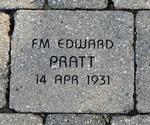Firefighter Record
Firefighter Details
| Name | Edward Pratt |
| Agency | Chicago Fire Department |
| Rank | Firefighter |
| Type of Firefighter | Career |
| Age Range | 21 to 25 |
| Sex | Male |
| Date of Birth | 4/6/1906 |
| Date of Death | 4/13/1931 |
| Cause of Death | Caught/Trapped , Contact/Exposure |
| Nature of Death | Asphyxiation |
| Attribute of Death | Smoke inhalation |
| Type of Duty | Firefighting operations , Search and rescue operations |
Incident Summary
On April 13, 1931, four firefighters from the Chicago Fire Department died in the line of duty during a fire in an underground sewer tunnel. Captain Timothy O’Neill of Truck 14, Firefighter Edward Byron Pratt of Squad 8, and Firefighters William Coyne and William Karstens of Engine 23, along with seven sewer workers, died in the confines of a 450 foot sewer tunnel that was under construction thirty-five feet below the intersection of 22nd and Laflin Streets in Chicago.
The fire started at approximately 6:30 PM when sewer workers using a candle to try to locate a leak in the tunnel accidentally ignited some sawdust. The fire burned and spread for more than forty-five minutes before the fire department was alerted. Truck 14, commanded by O’Neill, was the first apparatus on the scene, and, seeing only a thin curl of smoke rising out of the tunnel, the five firefighters descended into the tunnel via its only access point: an elevator. None of the firefighters were wearing masks or oxygen tanks and fifteen minutes after they descended into the tunnel, three of the firefighters emerged, suffering from intense smoke inhalation. As O’Neill and another firefighter, along with several workers, were still in the tunnel, firefighters from Engine 23 entered the tunnel, but they, too, did not have masks or oxygen tanks and several of them were also overcome with smoke inhalation inside the tunnel. This scenario was repeated several times, as the limited access to the tunnel did not give fire officers an accurate understanding of the intensity of the fire, smoke, and gases inside the tunnel. During the next two hours, more than fifty firefighters who had entered and exited the tunnel were suffering from smoke inhalation injuries. While injured firefighters were rescued during these operations, some of the rescuers became trapped or injured themselves down in the tunnel.
The fire department was soon informed by the construction company about the possibility that some of the missing firefighters and sewer workers could have sealed themselves inside an airtight compartment at one end of the tunnel. In actuality, sixteen missing firefighters and sewer workers had sealed themselves inside the compartment, but their only means of escape was blocked by the fire, smoke, and gases. Firefighters on the surface, however, continued to descend into the tunnel throughout the night, in an effort to reach their trapped colleagues. Every firefighter was now equipped with masks and oxygen tanks, some loaned by suburban fire departments eager to contribute to the rescue efforts.
Also during the night, a smoke ejector machine, designed by Chief Charles W. Ringer of the Minneapolis Fire Department, was delivered to Chicago from the manufacturer in Kenosha, Wisconsin. The machine consisted of a massive fan mounted on a truck, with an intake tube that could be placed inside the tunnel. The machine was put into operation at daylight, and it soon evacuated most of the smoke and toxic gases from the tunnel. The sixteen firefighters and sewer workers sealed in the airtight compartment were soon able to escape, and, over the next few hours, firefighters were able to recover the bodies of the dead firefighters and sewer workers from the tunnel.
Citations:
“9 Killed in Fiery Tunnel,” Chicago Daily Tribune, April 14, 1931.
“Brave Death in Tunnel Rescues,” Chicago Daily Tribune, April 15, 1931.
Kathleen M’Laughlin, “Hero Describes Night Spent in Death Tunnel,” Chicago Daily Tribune, April 15, 1931.
“List of Killed and Rescued in Fire Disaster,” Chicago Daily Tribune, April 14, 1931.
“Complete List of the Dead, Injured, and Rescued,” Chicago Daily Tribune, April 15, 1931.
“Plan for Victims’ Funeral,” Chicago Daily Tribune, April 15, 1931.
“Story of Heroic Tunnel Rescue of Trapped Men,” Chicago Daily Tribune, April 15, 1931.
“Firemen to be Honorguards at Comrades’ Rites,” Chicago Daily Tribune, April 16, 1931.
“City Hall Wears Mourning for Firemen Heroes,” Chicago Daily Tribune, April 17, 1931.
“Hundreds Honor Tunnel Heroes at Last Rites,” Chicago Daily Tribune, April 18, 1931.
“Pay Last Honor to Firemen Hero of Fatal Tunnel,” Chicago Daily Tribune, April 19, 1931.
